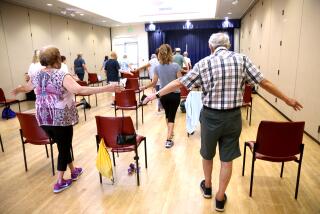For Seniors : A 21st-Century Challenge: Keeping Retirees Active
- Share via
Research says the idea that the average American might live to be 100 is not remote. Demographics say a third of Americans will be over 50 before the year 2030. Psychologists state that older workers are more reliable, highly productive and generally have better attendance rates than their younger counterparts.
So what’s the corporate response? Buyouts, golden handshakes and early retirement.
Enter Helen Dennis, USC’s expert on non-financial retirement planning. It’s five years before 2000 but she’s already asking what is sure to be one of the most relevant questions of the 21st Century: What will society do with a pool of retired people who still have a lot to offer the community?
“As a society, we don’t do a good job for people who seek a challenge after they’ve been told by a company, ‘You’re too old to work here anymore,’ ” she said. “There’s no clear or meaningful role for individuals with experience and leadership ability after they’ve left the workplace.”
Dennis was attending Cal State Long Beach in the early 1970s, looking for a topic for her master’s thesis, when she randomly picked up a library book titled “Cognition and Aging” by Warner Schaie. She was intrigued.
“My father-in-law was ill at the time, so I was spending part of each day visiting with him at a nursing home, thinking, ‘Something has to be done.’ My thesis title ended up to be ‘Remotivational Therapy’--a study of techniques used to reactivate sensory awareness in old, schizophrenic patients,” she said. Many of the concepts were adapted to frail, older people.
USC asked her to lecture, and eventually she became interested in the issues of aging, employment and retirement. She has worked with 4,000 people, mostly male, in the upper echelons of companies and corporations. She addresses the kind of people who are where the buck usually stops but who often have little insight about what to do after the work stops.
The critical period, Dennis says, is when a worker gets into the late 50s. At that point, she says, there are several potential crises.
In a common scenario, one spouse--usually the husband--retires with the idea of adopting a life of leisure, while the wife, who entered the work force after the children were grown, loves her job and doesn’t want to retire. He’s used to giving orders and being the boss, and suddenly not only is he not working anymore but he’s faced with a new element in his relationship.
“Two dreams are in conflict,” Dennis says.
Another crisis is when the aging parents of the couple need them for emotional and social support. “That’s when two generations tap into the same resources. Any retirement plan must consider this problem,” Dennis says.
But probably the worst crisis, according to Dennis, is when the employee is symbolically told by being offered a buyout that the company no longer values his contribution.
“And there he stands, mid-50s, vital, thinking, ‘What I am going to do with the rest of my life?’--which could easily be 30 more years,” she said.
So, when Dennis speaks to an audience of employed people, she makes the following points:
Start thinking about the second half of your life while you’re young. Get used to the idea of increasing responsibility for your own life--no one is going to look after you, including the government. Plan the financial element as early as possible. Identify what makes life meaningful--what makes a day terrific, or a week? Do a little self-assessment, and list accomplishments and dreams.
If there could be a theme song for Dennis’ professional life, it’s “See What Needs to Be Done and Do It.” The beat is slow and it’s one foot in front of another while the body moves forward until the music stops. Not everyone can dance to it.






